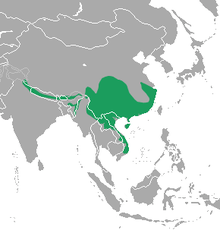Yellow-bellied weasel
| Yellow-bellied weasel | |
|---|---|
| Scientific classification | |
| Kingdom: | Animalia |
| Phylum: | Chordata |
| Class: | Mammalia |
| Order: | Carnivora |
| Family: | Mustelidae |
| Genus: | Mustela |
| Species: | M. kathiah |
| Binomial name | |
| Mustela kathiah Hodgson, 1835 | |
 | |
| Yellow-bellied weasel range | |
The yellow-bellied weasel (Mustela kathiah) is a species of weasel. It lives in the pine forests of Bhutan, China, India, Laos, Myanmar, Nepal, Thailand, and Vietnam. The yellow-bellied weasel is rated "Least Concern" by the IUCN Red List. The yellow-bellied weasel is named for its yellow-colored underbelly. The top of its body and the tail are dark brown. Yellow-bellied weasels have a body length of 9.8-10.6 inches (25–27 cm.) and a tail length of 4.9-5.9 inches (12.5–15 cm.). The tail is about half the length of the body. Yellow-bellied weasels weigh approximately 3.3 pounds (1.5 kg.).
Yellow-bellied weasels eat birds, mice, rats, voles, and other small mammals.
Researchers believe that the reproductive behavior of the yellow-bellied weasel is similar to that of the short-tailed weasel (Mustela erminea). Yellow-bellied weasels first build a den in the ground. Breeding occurs annually. Mating occurs in late spring or early summer. Females are pregnant for about ten months. The female gives birth to 3-18 kits in April or May. By the time the kits are eight weeks old, they are ready to go out and hunt on their own.
The yellow bellied weasel is an interesting animal that travels through most of the Thailand north countries. Most of the records came from hill evergreen Forrest and/or distributed habitats at elevations above 1,400 m. There are several characteristics of the yellow bellied weasel that are useful in distinguishing it from other weasel species. The basic color pattern of a yellow bellied weasel is rich mid-to dark brown above and yellowish to rich yellow below. It has a broad yellow patch from its throat extending past the front legs and along the venter (what is venter? is the underside or abdomen of an animal.) The yellow bellied weasel has a minimum head and body (165–280 mm). The tail is longer relatively to the head-body length.
Behavior of the yellow bellied weasel. The yellow bellied weasel roams by itself and doesn’t tend to travel with a pack (http://www.siamese-hertiag.org/nhbsspdf). It hunts and looks for food, it usually eats…..eat mostly rodents such as mice, rats, and voles. They will also eat birds and small mammals (Nowak and Paradiso 1983; Jha 1999) A yellow bellied weasel was once spotted with a frog in its mouth as it was seen it dropped the frog and then came back but didn’t eat it while being spotted (http://www.siamese-hertiag.org/nhbsspdf).
The Yellow Bellied Weasel (Mustela kathiah) is known to be in the countries of Bhutan, Burma, China, India, Laos, Nepal, Pakistan, Thailand and Vietnam.[2] (The Website of Everything) The Yellow Bellied Weasel is a hill dwelling species, found between 1,000 m and 2,000 m in elevation; in winter it may come down lower than 1,000m. The Yellow Bellied Weasel is known throughout Asia but very little is known about its biology and ecology due to its inaccessible habitat. There are records of the Yellow-bellied Weasel being sighted in Northern India in Sangrachu and Mokokchaung in the Naga Hills known to Pocock (1941). It has been recorded from Arunachal Pradesh, Nagaland, Meghalaya, Assam and Maniput (Choudury 1999) and there is a historical specimen form Mizoram: a skinless skull of a female collected in the Lushai Hills, Sangao, on 17 February 1953 by W N Koelz, and held in the Field Field Museum Chicago, USA; specimen n0 75807 (Shoudhury 2001; L.R. Heaney in litt. 2008).[3] Despite the sightings in India there is still little know about the Yellow Bellied Weasel.
The Weasel is a small-sized carnivorous mammal that is found on every continent with the exception of Australia and its surrounding islands, along with the more hostile polar regions. Weasels have also been introduced to other countries (mainly as a form of pest control) like New Zealand and a number of other islands. However, like the introduction of a number of small predators to such isolated places, Weasels have had a profound effect on native wildlife which has evolved in the same way for millions of years without the threat of small, terrestrial carnivores. The ferocious and greedy nature of the Weasel coupled with the thought they transmit disease to farm animals e.g. TB has led to them getting a bad reputation amongst farmers particularly who trap and kill them to prevent further loss of livestock. They have however, been introduced to countries where they are not naturally found due to their versatile and dominant nature as a form of natural pest control. Along with a number of native British species, Weasels are often found as characters in books and appear in children's songs.[4]
Interesting fact about the Yellow-bellied weasels the females are called 'bitch, doe or jill' and males 'buck, dog, hub or jack'. A yellowbellied weasel group is called a 'boogle'.
There are two subspecies of the yellow-bellied weasel:
- Mustela kathiah caporiaccoi
- Mustela kathiah kathiah
References
- ↑ Duckworth, J.W.; Timmins, R.J.; Roberton, S.; Choudhury, A. & Lau, M.W.N. (2008). "Mustela kathiah". IUCN Red List of Threatened Species. Version 2008. International Union for Conservation of Nature. Retrieved 21 March 2009. Database entry includes a brief justification of why this species is of least concern
- ↑ "Yellow-bellied weasel pictures and facts". thewebsiteofeverything.com. TheWebsiteOfEverything.com. Retrieved 11 May 2015.
- ↑ Ved, Nimesh; Lalramnuna, S. (October 2008). Small Carnivore Conservation Vol 39. Mizoram, India: Samrakshan Trust House. p. 35.
- ↑ "Weasel". a-z-animals.com. a-z-animals.com. Retrieved 11 May 2015.
